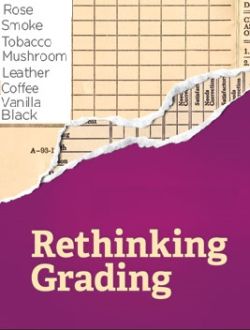Since 1949, AB Bookman’s Weekly, which ceased publication 50 years later, strived to establish the criteria for grading the condition of used books. AB’s definitions of “Very Fine” (or “As New”), “Fine”, “Very Good”, “Good”, “Fair”, and so forth, have basically become the industry standard. The condition of each book is, in a very real sense, unique, and the best and most accurate way to spot flaws, can only be achieved through a close examination by the prospective buyer. Nothing can speak more truth regarding the condition (and value assessment) of a collectible book than a good, old-fashioned “look and feel” examination. Opening the covers and flipping through the pages gives a sense of the crispiness and perhaps fragility of the book’s components, while drawing it closer and inhaling deeply one can perhaps catch a beautiful bouquet or a foul repellent.
Using olfactory judgment to determine the condition of a book is an important aspect of close examination. Could a book fairly be described as “fine” if it smells bad? Recently, new research has been made on the “old book aroma”, as organic chemistry advancements have isolated the biosynthetic behavior of compounds that occupy rare books. By monitoring the concentrations of different organic compounds that books give off, chemists have been able to identify some of the many compounds that contribute to the book’s smell. Whether the aroma originates from heavily foxed and quite often damp storage conditions, or by dampness, thus causing a frowzy, sweet-smelling bouquet, there is a whole new science now around the fragrance of the old book.
New paper making techniques and the variety of chemicals used in the adhesives, inks and texture preparation of the papers, complicate the identification of common compounds that affect the new book smell. In the case of old books, the domain of natural polymers consisting of only cellulose, lignin and hemicelluloses, is narrow enough for chemists to identify the origins of their smell as they undergo chemical degradation. The two compounds that dominate these studies are lignin and furfural.
Lignin, which is the second most abundant natural polymer in our world, helps plants by reducing evaporation and channeling water to critical areas of the plant. Older paper, which carries some small amounts of lignin, contain in its composition, an aromatic ring which is receptive to surrounding acids. Lignin chemical reactions, such as acid hydrolysis, produce a wide range of volatile organic compounds, many of which contribute to the smell of old books. For example, benzaldehyde and ethyl benzene can contribute a sweet, nutty-like scent, while vanillin adds a vanilla-like scent, and 2-ethyl hexanol produces a rather flowery composition. Lignin is also responsible for old papers which yellow with age, as oxidation reactions cause a breakdown into acids.
Furfural, which is usually derived from a variety of agricultural byproducts, is also present in old books. It is a colorless oily liquid with the odor of almonds, which turns reddish brown when exposed to air and light. Its properties can be used to determine the age and composition of old books. Research has shown that books published after the mid-1800s are emitting more furfural, and the compound’s emission generally increase with the more recent publication years for the ones composed of cotton or linen paper.
Hopefully, in the near future, a new scientifically accurate book grading system will be given a formal, universal definition and replace a 50-year old generalization. My vote is for primary criteria that include, among other things, color and odor. My old book descriptions may soon read something like: Yellow #5, Red #2, Vanilla 1.5, Almond 0.7 with extraneous 2 parts mold, mildew or fungus, 1 part dogs, 2 parts tobacco, 1 part coffee, 1 part mothballs and 7 parts dust (not sure if dust smells like anything)….
1CRC Press, “Lignin and Lignans Advances in Chemistry,” Cyril Heitner; Donald R. Dimmer, John A. Schmidt (editors),(2010).
2Compound Interest. “What Causes the Smell of New & Old Books? “

{ 0 comments… add one now }